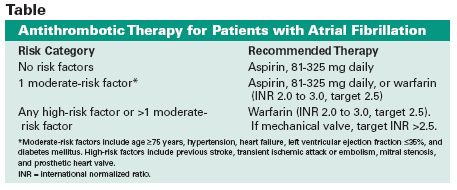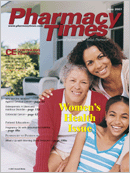Current Recommendations for Atrial Fibrillation
Atrial fibrillation (AF) is a common form of arrhythmia that affects ~2.2 million Ameri-cans.1-3 It is estimated that ~15% of the strokes that occur in the United States are due to complications of AF.1-3 The risk of developing AF increases with age, is more prevalent in men, and often is associated with underlying heart disease.1-3 Currently, there are 2 options for the management of AF: rhythm control and rate control strategies. The rhythm control strategy involves cardioversion with antiarrhythmic drugs or electrical current, followed by maintenance of sinus rhythm. With the rate-control strategy, the ventricular rate is controlled without restoring sinus rhythm.
Recently, the American College of Cardiology (ACC), the American Heart Association (AHA), and the European Society of Cardiology published detailed recommendations for the treatment of patients with AF.1 The following includes selected excerpts from the recommendations described in these guidelines.
Definitions
The usual ACC/AHA recommendations are used in these guidelines:
- Class I: Conditions for which there is evidence for and/or general agreement that the procedure or treatment is useful and effective
- Class II: Conditions for which there is conflicting evidence and/or a divergence of opinion about the usefulness/efficacy of a procedure or treatment Class IIa: Weight of evidence/opinion is in favor of the procedure or treatment. Class IIb: Usefulness/efficacy is less well-established by evidence/opinion.
- Class III: Conditions for which there is evidence and/or general agreement that the procedure/ treatment is not useful or effective and in some cases can be harmful
- First detected AF: First-detected episode of AF may or may not be symptomatic or self-limited.
- Recurrent AF: After 2 or more episodes, the AF is considered recurrent.
- Paroxysmal AF: If arrhythmia terminates spontaneously, recurrent AF is designated paroxysmal.
- Persistent: When AF is sustained beyond 7 days, it is termed persistent.
- Permanent: In long-standing persistent AF, usually longer than 1 year, car-dioversion has failed or has been forgone.

Recommendations for Pharmacologic Rhythm-Control Strategy
Class I
Administration of flecainide, dofetilide, propafenone, or ibutilide is recommended for pharmacologic cardioversion of AF.
Class IIa
1. Administration of amiodarone is a reasonable option for pharmacologic cardioversion of AF.
2. A single oral bolus dose of pro-pafenone or flecainide (?pill in the pocket?) can be administered to terminate persistent AF outside the hospital once treatment has proved safe in the hospital for selected patients without sinus or atrioven-tricular (AV) node dysfunction, bundle branch block, QT-interval prolongation, the Brugada syndrome, or structural heart disease. Before antiarrhythmic medication is initiated, a ?-blocker or a nondihydropyri-dine calcium channel antagonist should be given to prevent rapid AV conduction in the event that atrial flutter occurs.
3. Administration of amiodarone can be beneficial on an outpatient basis in patients with paroxysmal or persistent AF when rapid restoration of sinus rhythm is not deemed necessary.
Class IIb
Administration of quinidine or pro-cainamide might be considered for pharmacologic cardioversion of AF, but the usefulness of these agents is not well-established.
Class III
1. Digoxin and sotalol may be harmful when used for pharmacologic car-dioversion of AF and are not recommended.
2. Quinidine, procainamide, disopyra-mide, and dofetilide should not be started out of the hospital for conversion of AF to sinus rhythm.
Recommendations for Rate-Control Strategy
Class I
1. Measurement of the heart rate (HR) at rest and control of the rate using pharmacologic agents (either a b-blocker or a nondihydropyridine calcium channel antagonist, in most cases) are recommended for patients with persistent or permanent AF.
2. In the absence of preexcitation, intravenous (IV) administration of b-blockers (esmolol, metoprolol, or propranolol) or nondihydropyridine calcium channel antagonists (vera-pamil or diltiazem) is recommended to slow the ventricular response to AF in the acute setting. Caution should be exercised in patients with hypotension or heart failure (HF).
3. IV administration of digoxin or amiodarone is recommended to control the HR in patients with AF and HF who do not have an accessory pathway.
4. In patients who experience symptoms related to AF during activity, the adequacy of HR control should be assessed during exercise, adjusting pharmacologic treatment as necessary to keep the rate in the physiologic range.
5. Digoxin is effective following oral administration to control the HR at rest in patients with AF and is indicated for patients with HF or left ventricular (LV) dysfunction or for sedentary individuals.
Class IIa
1. A combination of digoxin and either a ?-blocker or a nondihydropyridine calcium channel antagonist is reasonable to control the HR both at rest and during exercise in patients with AF. The choice of medication should be individualized and the dose modulated to avoid bradycardia.
2. It is reasonable to use ablation of the AV node or accessory pathway to control the HR when pharmacologic therapy is insufficient or associated with side effects.
3. IV amiodarone can be useful to control the HR in patients with AF when other measures are unsuccessful or contraindicated.
4. When electrical cardioversion is not necessary in patients with AF and an accessory pathway, IV pro-cainamide or ibutilide is a reasonable alternative.
Class IIb
1. When the ventricular rate cannot be controlled adequately both at rest and during exercise in patients with AF using a b-blocker, a nondihy-dropyridine calcium channel antagonist, or digoxin, alone or in combination, oral amiodarone may be administered to control the HR.
2. IV procainamide, disopyramide, ibu-tilide, or amiodarone may be considered for hemodynamically stable patients with AF involving conduction over an accessory pathway.
3. When the rate cannot be controlled with pharmacologic agents or when tachycardia-mediated cardiomyopa-thy is suspected, catheter-directed ablation of the AV node may be considered in patients with AF to control the HR.
Class III
1. Digitalis should not be used as the sole agent to control the rate of ventricular response in patients with paroxysmal AF.
2. Catheter ablation of the AV node should not be attempted without a prior trial of medication to control the ventricular rate in patients with AF.
3. In patients with decompensated HF and AF, IV administration of a nondi-hydropyridine calcium channel antagonist may exacerbate hemody-namic compromise and is not recommended.
4. IV administration of digitalis glyco-sides or nondihydropyridine calcium channel antagonists to patients with AF and a preexcitation syndrome may paradoxically accelerate the ventricular response and is not recommended.
Antithrombotic Therapy
Preventing thromboembolism also is discussed and is recommended for patients with AF. The Table summarizes the recommendations for antithrombotic therapy for patients with AF.1
Dr. Tafreshi is an associate professor and director of cardiology pharmacy practice residency at Midwestern University College of Pharmacy-Glendale (MWU-CPG), Glendale, Ariz. At the time of submission of this article, Drs. Khan and Rich-Crosland were both senior pharmacy students at MWU-CPG.
References
1. Fuster V, Ryden LE, Cannom DS, et al. A Report of the American College of Cardiology/American Heart Association Task Force on Practice Guidelines and the European Society of Cardiology Committee for Practice Guidelines. ACC/AHA/ESC 2006 Guidelines for the Management of Patients with Atrial Fibrillation. J Am Coll Cardiol. 2006;48:e149-246.
2. DiPiro J, Talbert R, Yee G, et al. Pharmacotherapy: A Pathophysiologic Approach. 6th ed. New York, NY: McGraw-Hill; 2005: 17:329-335.
3. American Heart Association. Atrial Fibrillation. Available at: www.americanheart.org/presenter.jhtml?identifier=4451. Accessed February 2, 2007.

